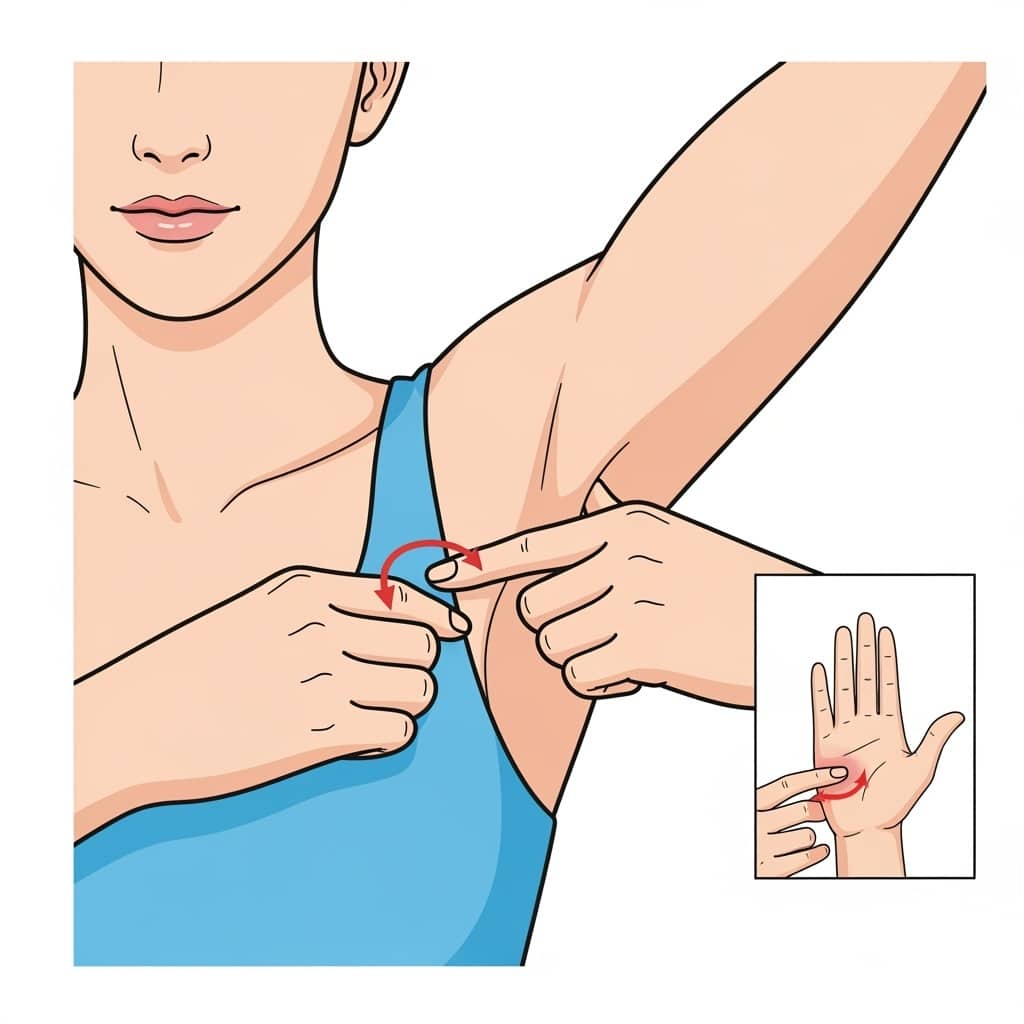What does a lump under the armpit mean?
Finding a lump under your armpit can send your mind racing with worry. Your fingers detect something that wasn't there before, and anxiety kicks in. You're not alone in this experience. During my years practicing as a radiologist in both NHS and private settings at International Ultrasound Services in London, countless patients have walked through our doors with the same concern.
The reassuring truth is that the vast majority of armpit lumps are completely harmless. Research published in the British Journal of Surgery indicates that over 80% of lumps discovered in the axillary region prove to be benign upon examination. Your body contains numerous structures under the armpit that can create lumps for perfectly normal reasons.
Understanding what you're feeling and when to seek professional evaluation will help you make informed decisions about your health. This knowledge transforms anxious uncertainty into confident action.

What Creates Lumps Under Your Armpit
Your armpit houses a complex network of lymph nodes, blood vessels, nerves, and soft tissues. Multiple factors can cause these structures to become enlarged or create detectable lumps.
Swollen Lymph Nodes
Lymph nodes represent your body's filtration system, trapping bacteria, viruses, and other unwanted materials. When they're doing their job fighting infection, they swell. A study published in the Journal of Clinical Medicine found that lymph node enlargement occurs in approximately 60% of adults following viral infections.
Your lymph nodes enlarge when you have a cold, throat infection, or even after receiving vaccinations. The COVID-19 vaccine, flu shots, and other immunizations commonly cause temporary lymph node swelling that can last several weeks. This swelling feels soft, moves when pressed, and often feels tender.
Recent dental work, cuts on your hands or arms, or skin infections can also trigger lymph node enlargement. Your immune system responds to these minor injuries by activating nearby lymph nodes.
Lipomas
Lipomas are soft, fatty lumps that develop under the skin. Research in the American Journal of Surgery shows these benign tumors affect approximately 1% of the population. They feel soft, doughy, and move easily when pressed. Lipomas grow slowly over months or years and rarely cause discomfort.
These fatty lumps run in families and typically appear in middle age. They can occur anywhere on your body, including under your arms. While completely harmless, some people choose removal for cosmetic reasons.
Sebaceous Cysts
Sebaceous cysts develop when hair follicles become blocked with oil and dead skin cells. These rounded lumps feel firm and may have a small dark spot in the center. They can remain stable for years or occasionally become infected, causing redness, warmth, and tenderness.
A study in the Journal of Cutaneous Medicine and Surgery found that sebaceous cysts occur most frequently in areas with dense hair follicles, making the armpit a common location.
Hidradenitis Suppurativa
This chronic skin condition affects the sweat glands in areas where skin rubs together. The condition creates painful lumps that can break open and heal with scarring. Research published in the British Journal of Dermatology indicates this condition affects approximately 1% of the population, with women being three times more likely to develop it than men.
The lumps from hidradenitis suppurativa feel deep, painful, and may drain fluid. They tend to recur in the same locations and can significantly impact quality of life.
Physical Causes
Muscle strain from exercise, lifting heavy objects, or repetitive arm movements can create lumps or swelling under your armpit. The pectoral muscles extend into this area, and strain can cause noticeable changes.
Deodorant reactions, ingrown hairs, and blocked sweat glands also create lumps. These typically feel superficial, close to the skin surface, and may be accompanied by redness or irritation.
Recognising Concerning Signs
While most armpit lumps prove harmless, certain characteristics warrant immediate medical attention. Understanding these warning signs helps you respond appropriately to your symptoms.
Hard, Fixed Lumps
Lumps that feel rock-hard and don't move when pressed require prompt evaluation. Malignant tumours often feel firm and seem attached to deeper tissues. A study published in the Annals of Surgical Oncology found that immobile lumps in the axillary region have a significantly higher likelihood of malignancy compared to mobile ones.
These concerning lumps typically don't hurt, which can be misleading. Many people assume painful lumps are more serious, but the opposite is often true. Cancerous lumps frequently cause no discomfort in their early stages.
Rapid Growth
Lumps that appear suddenly or grow noticeably over days or weeks need immediate assessment. Benign lumps typically grow slowly over months or remain stable. Research in the European Journal of Cancer shows that rapidly enlarging lymph nodes have a higher probability of malignancy, particularly when growth occurs over less than four weeks.
Document any changes you notice. Take photos if possible, and measure the lump with a ruler to track size changes objectively.
Associated Symptoms
Certain symptoms accompanying your armpit lump raise concern levels significantly. Unexplained weight loss, persistent fever, drenching night sweats, or extreme fatigue combined with a lump require urgent medical evaluation.
A report in the journal Cancer Epidemiology showed that axillary lymphadenopathy was present in about 10-15% of patients at the time of initial breast cancer diagnosis, and often correlated with more advanced disease.
Changes in your breast tissue on the same side as the lump also warrant immediate attention. Skin dimpling, nipple discharge, or breast texture changes can indicate cancer spread to axillary lymph nodes.
Multiple Lumps
Finding multiple enlarged lymph nodes in your armpit, neck, or groin simultaneously can indicate systemic conditions like lymphoma. A study in the Journal of Clinical Oncology found that patients with lymph node enlargement in multiple body regions have a higher likelihood of hematologic malignancies.
Single enlarged lymph nodes more commonly result from localized infections or benign causes.
Skin Changes
Lumps accompanied by skin redness, warmth, or texture changes need evaluation. Inflammatory breast cancer can cause skin changes resembling orange peel texture, while infections create redness and warmth.
Any lump that breaks through the skin or creates open sores requires immediate medical attention.
Reassuring Characteristics
Many lumps under your armpit have characteristics that suggest benign causes. Recognizing these features can provide peace of mind while you arrange professional evaluation.
Soft, Mobile Lumps
Lumps that feel soft, squishy, or rubbery and move easily when pressed are typically benign. Lipomas, reactive lymph nodes, and cysts all share these characteristics. Research published in the American Journal of Medicine found that mobile lumps in the axillary region have less than a 5% chance of malignancy.
These lumps often feel like a marble or grape under your skin that you can push around slightly.
Tenderness
Painful or tender lumps usually indicate benign processes. Infections, reactive lymph nodes, and cysts commonly cause discomfort. A study in Clinical Radiology showed that painful axillary lumps are significantly more likely to be benign compared to painless ones.
The tenderness often correlates with the underlying cause. Infected lumps feel very tender, while reactive lymph nodes cause mild discomfort.
Cyclical Changes
Lumps that come and go with your menstrual cycle typically relate to hormonal fluctuations. Breast tissue extends into the armpit area, and hormonal changes can cause temporary swelling or lumpiness.
Document these changes in relation to your cycle. Lumps that consistently appear before menstruation and resolve afterward rarely indicate serious problems.
Recent Illness Connection
Lumps that appear after recent illness, vaccination, or minor injuries usually represent normal immune responses. Your lymph nodes can remain enlarged for several weeks after infections resolve.
Keep track of recent health events. Upper respiratory infections, dental procedures, cuts, or scratches on your arms can all trigger lymph node enlargement that persists for weeks.
Stable Size
Lumps that remain unchanged for months suggest benign processes. Cancerous lumps typically grow progressively, while benign lumps often stay stable or grow very slowly over years.
Regular self-examination helps you monitor stability. Check monthly and note any changes in size, texture, or mobility.

Your Ultrasound Examination Experience
Ultrasound is the fastest and most accurate first-line tool for evaluating a lump. High-frequency ultrasound can distinguish between solid and cystic structures, assess the internal characteristics of a lump, and provide accurate measurements.
When scanning a lymph node, sonographers assess size, shape, border definition, vascular pattern, and internal structure. Benign reactive nodes are usually oval, with a preserved fatty hilum and show blood flow only at the hilum. Suspicious lymph nodes often appear rounder, lose the central hilum, and show chaotic internal blood flow.
A study published in the Journal of Ultrasound in Medicine confirmed that cortical thickening and absence of the fatty hilum are two of the strongest ultrasound predictors of malignancy in axillary nodes.
Lipomas appear as homogenous, well-defined, and hypoechoic (darker) structures with minimal vascularity. Cysts are anechoic (black) on ultrasound and have thin walls. Boils or abscesses have mixed echogenicity and may show internal debris or septations.
At International Ultrasound Services, all scans are carried out by experienced consultant radiologists with NHS backgrounds. Our team applies these standardised features to identify the cause of a lump during the scan. Most patients receive immediate results and guidance.
Who should book a scan
Anyone who has noticed a lump under the armpit that has persisted for more than a week should consider a scan. This is especially true if:
The lump is growing
It feels firm or immobile
There is associated fatigue or night sweats
There is a personal or family history of cancer
There are enlarged lymph nodes elsewhere (neck, groin)
According to NICE guidelines, patients with unexplained lumps or those with high-risk features should undergo imaging within two weeks. Early detection often changes outcomes.
Why Ultrasound Works Best
Ultrasound waves create detailed images of soft tissues, allowing radiologists to distinguish between different types of lumps with high accuracy. Research in the European Journal of Radiology demonstrates that ultrasound correctly identifies benign versus malignant axillary lumps in over 90% of cases.
The technology shows blood flow patterns within lumps, tissue architecture, and relationships to surrounding structures. These details help determine whether further investigation is needed.
What Happens During Your Scan
Your ultrasound appointment typically lasts 15-30 minutes. You'll lie on an examination table with your arm raised above your head to expose the armpit area. The sonographer applies gel to your skin and uses a handheld probe to capture images.
The procedure feels completely painless. You might feel slight pressure as the probe moves across your skin, but no discomfort occurs. Many patients find the experience reassuring because they can see their scan in real-time.
Real-Time Assessment Advantages
Unlike other imaging studies, ultrasound provides immediate results. The radiologist can examine your lump while you're present and often provide preliminary feedback during the examination.
This immediate feedback reduces anxiety significantly. Instead of waiting days for results, you receive expert assessment during your appointment. The radiologist can explain what they're seeing and discuss next steps immediately.
Different Lump Appearances
Benign lumps typically appear oval-shaped with smooth edges and uniform internal structure on ultrasound. Lipomas look like dark, uniform areas, while cysts appear as fluid-filled spaces with thin walls.
Malignant lumps often have irregular shapes, uneven edges, and mixed internal patterns. They may show increased blood flow and appear to invade surrounding tissues.
Measurement and Documentation
During your scan, precise measurements are taken from multiple angles. These measurements help track changes over time if monitoring is recommended. The radiologist documents all findings in a detailed report that becomes part of your medical record.
High-quality images are saved for comparison with future scans if needed. This documentation proves invaluable for monitoring stable lumps or assessing treatment response.
Treatment Approaches Based on Diagnosis
Treatment recommendations depend entirely on your specific diagnosis. Many lumps require no treatment beyond monitoring, while others need active intervention.
Observation and Monitoring
Benign lumps often require only regular monitoring. Your doctor might recommend checking the lump monthly and returning for follow-up if changes occur. This approach works well for stable lipomas, small reactive lymph nodes, and simple cysts.
Studies published in the Journal of Surgical Research show that observation remains safe for clearly benign lumps, with less than 2% requiring later intervention. Regular monitoring avoids unnecessary procedures while maintaining safety.
Antibiotic Treatment
Infected lumps respond well to antibiotic therapy. Bacterial infections in lymph nodes, sebaceous cysts, or hidradenitis suppurativa often resolve with appropriate antibiotics. Your doctor selects antibiotics based on the likely causative bacteria and your medical history.
Treatment typically lasts 7-14 days, with improvement expected within 48-72 hours. Warm compresses can provide additional comfort during treatment.
Surgical Removal Options
Some benign lumps warrant surgical removal for various reasons. Large lipomas that cause discomfort, recurrent infected cysts, or lumps causing anxiety might be removed even when benign.
Modern surgical techniques minimize scarring and recovery time. Most procedures can be performed under local anesthesia in outpatient settings. Recovery typically takes 1-2 weeks with minimal activity restrictions.
Specialist Referrals
Concerning lumps require specialist evaluation. Oncologists, surgeons, or hematologists provide expert assessment and treatment planning for potentially malignant lumps. Early referral ensures prompt treatment if cancer is diagnosed.
The referral process moves quickly for urgent cases. NHS urgent cancer referrals typically result in specialist appointments within two weeks. Private consultations can often be arranged within days.
Follow-Up Care
Regular follow-up appointments help monitor treatment response and detect any changes. Even benign lumps benefit from periodic reassessment to ensure they remain stable.
Your healthcare team creates a personalized follow-up schedule based on your specific situation. Some patients need quarterly checks, while others require only annual assessments.
Self-Care and Prevention Strategies
Several strategies can help prevent armpit lumps and support your overall lymphatic health. These approaches work particularly well for lumps related to hygiene, infections, or lifestyle factors.
Proper Hygiene Practices
Regular bathing with gentle cleansers helps prevent bacterial buildup that can lead to infections. Avoid harsh scrubbing, which can irritate hair follicles and create ingrown hairs. Pat the area dry thoroughly after showering to prevent moisture accumulation.
Choose deodorants and antiperspirants carefully. Products containing aluminum or strong fragrances can cause skin reactions in sensitive individuals. Switch to hypoallergenic options if you notice irritation or lumps after using new products.
Clothing Considerations
Tight-fitting clothing and bras can restrict lymphatic drainage and increase friction. Choose breathable fabrics that allow air circulation. Properly fitted undergarments reduce chafing and irritation that can lead to lumps.
Natural fibers like cotton and bamboo wick moisture away from skin better than synthetic materials. This moisture control helps prevent bacterial growth and reduces infection risk.
Self-Examination Techniques
Monthly self-examinations help you become familiar with your normal anatomy and detect changes early. Perform checks during or after showering when your skin is clean and relaxed.
Use your fingertips to feel systematically around your armpit area. Press gently but firmly, moving in circular motions. Check the same way each month to ensure consistency. Note any changes in size, texture, or mobility of existing lumps.
Immune System Support
Maintaining a strong immune system helps your body fight infections that can cause lymph node enlargement. Regular exercise, adequate sleep, stress management, and balanced nutrition all support immune function.
Research published in the International Journal of Environmental Research and Public Health shows that people with healthier lifestyles experience fewer infections and faster recovery when illness occurs.
Managing Anxiety
Finding a lump naturally creates anxiety, but excessive worry can interfere with appropriate medical care. Some people avoid medical evaluation due to fear, while others seek unnecessary repeated testing.
Deep breathing exercises, mindfulness techniques, and staying informed about your condition can help manage anxiety. Talking with trusted friends or family members about your concerns often provides emotional support.
Frequently asked questions at the clinic
Is a lump under the armpit always cancer?
No. Most underarm lumps are benign. Inflammatory causes, lipomas, and cysts are far more common than malignancies. That said, it takes an ultrasound to be sure.
Do men get armpit lumps?
Yes. Men also have lymph nodes, fat tissue, and sweat glands in the axilla. Infections, cysts, and tumours can affect them just the same. Lymphomas and melanoma secondaries should always be considered in firm or growing lumps.
Can I have the scan if I'm pregnant?
Yes. Ultrasound is completely safe in pregnancy. There is no radiation. Many pregnant patients undergo scans for breast and armpit lumps.
How soon will I get the results?
In most cases, our radiologist will explain the findings immediately after the scan and provide a printed or digital report on the same day.
Do I need a GP referral?
You can self-refer to International Ultrasound Services. Many patients contact us directly when they feel a lump, and we can usually offer same-day or next-day appointments.
What makes International Ultrasound Services different
All scans at our London clinic are carried out by consultant radiologists who also work in NHS hospitals. We see a high volume of patients with concerns about armpit lumps and bring years of direct diagnostic experience.
Our reports are detailed, accurate, and written in clear language. We maintain strong links with local GPs and specialists and can arrange referrals quickly when needed.
Patients trust our service because of our transparency, speed, and clinical focus. The technology we use is hospital-grade, and our scanning protocols match national diagnostic standards.
We believe that no one should wait weeks to get answers about a new lump. Timely ultrasound gives clarity. It informs the next step, whether that’s reassurance or action.



